An exclusive look behind the scenes at the Nantucket Cottage Hospital.
Six months ago, most of us had never heard the term “coronavirus.” Now the word is ingrained in our collective conscience. More than 100,000 people in the U.S. have died due to the novel coronavirus, and 40 million Americans are unemployed as a result of the restrictions put in place to slow its spread across the country.
 It’s unclear how this will all end, or when. But for now at least, Nantucket has emerged from the initial wave of coronavirus as an improbable public health success story. Lodged between two of the epicenters of the pandemic – New York City and Boston – the island has so far largely escaped the tragedies that have unfolded in those cities. Nantucket’s geographic isolation, along with early and decisive action by town leaders and the collective willpower of the community to adhere to prevention guidelines, have resulted in an incredibly low infection rate — just fourteen confirmed cases of COVID-19 as of June 1 — and one death. With the summer looming as a great unknown, Nantucket is grasping to strike the right balance between public health measures to keep the virus at bay and accommodating the reopening of the economy to preserve the livelihoods of thousands of island residents.
It’s unclear how this will all end, or when. But for now at least, Nantucket has emerged from the initial wave of coronavirus as an improbable public health success story. Lodged between two of the epicenters of the pandemic – New York City and Boston – the island has so far largely escaped the tragedies that have unfolded in those cities. Nantucket’s geographic isolation, along with early and decisive action by town leaders and the collective willpower of the community to adhere to prevention guidelines, have resulted in an incredibly low infection rate — just fourteen confirmed cases of COVID-19 as of June 1 — and one death. With the summer looming as a great unknown, Nantucket is grasping to strike the right balance between public health measures to keep the virus at bay and accommodating the reopening of the economy to preserve the livelihoods of thousands of island residents.
For Nantucket Cottage Hospital (NCH), where I serve as public information officer, it’s not an exaggeration to say the past six months have changed just about everything. While we gratefully have not yet faced the surge of COVID-19 patients that larger hospitals did on the mainland, the pandemic required NCH to transform itself in order to properly protect patients and staff, actively test for the virus, and plan for the worst case scenario. As the sole medical facility on the island, the community turned to NCH for guidance, reassurance, and answers amid the uncertainty caused by the virus. The relentless speed and intensity of the pandemic response over the past six months have been draining for the hospital’s workforce, but in many ways it has brought the staff together, and prompted an outpouring of love and support from the community that has lifted spirits more than we could have imagined.
Preparations at NCH got underway in mid-January as we all digested the news of the outbreak in Wuhan, China, and began taking stock of the personal protective equipment (PPE) we had available and doing what we could to obtain more. In late-January, NCH activated its Hospital Incident Command Structure, which brings together staff from across NCH to improve our emergency management planning and response. We were immediately looped into Massachusetts General Hospital’s Incident Command and the broader Partners HealthCare system, a line of communication and coordination that would prove invaluable throughout the crisis. Readying our response was NCH’s new president and CEO Gary Shaw, who had been appointed by the Board of Trustees just two months before the pandemic arrived. Shaw’s background included twenty years of service in the U.S. Navy as an Environmental Health Officer with a focus on public health and communicable disease. Somehow, it seemed, NCH had found the right leader with a skill-set and experience perfectly aligned for the moment and the challenges we faced. Shaw encouraged us on a near daily basis to “lean into” the response effort and the task of preparing a small community hospital for a global pandemic. The staff responded well to his leadership.
One of Shaw’s first important moves as CEO was to ask Dr. Diane Pearl to step in as interim Chief Medical Officer for the hospital. Dr. Pearl, an island native, has been a physician on Nantucket for more than thirty years. Her decades of experience, clinical skills, and perhaps most of all, her local knowledge of the island and its population, were invaluable in planning and communicating the hospital’s response.
“Sometimes the responsibility was daunting to keep up with all the information about this new disease, the recommendations to protect patients and staff, to diagnose and follow these patients properly,” Dr. Pearl said. “But every day I was reassured to be part of such an energetic, focused and committed team at NCH that I knew we could do this work well.”
In early March, we watched the reports coming out of northern Italy with growing alarm – hospitals overflowing, ICUs reaching capacity, and patients dying in the hallways or not even making it to the hospital. While the information about the virus was constantly evolving, we understood at the time that 20 percent of those infected required hospitalization, and 5 percent would need ICU-level care. So we did the math for Nantucket, assuming 15 percent of the island would become infected, and saw we could be facing more than 500 hospitalizations and 125 patients needing an ICU bed. With fourteen licensed inpatient beds, a twelve-room emergency department, and no ICU beds, the possibility that our hospital could become overwhelmed seemed very real.
Our communications to the community reflected that potential scenario. Well before the island’s first confirmed case of COVID-19, we were urging residents to act as if the virus was already on Nantucket, to take the threat extremely seriously, and adhere to all the recommended precautions. We also requested that those who were considering taking refuge on the island from elsewhere stay home. It was a strategic yet controversial stance, and there was no shortage of praise or criticism of NCH for voicing it.
 By March 15th, Nantucket Cottage Hospital was completely transformed, significantly altering our entire operation in preparation for the pandemic to hit. Access to the hospital was restricted to the ER entrance only, allowing us to screen everyone who came through the door: patients, visitors and staff. All elective surgeries, procedures, and routine care visits were cancelled to reduce the traffic through the hospital and the potential for transmission. Our 24/7 clinical departments – the ER, the inpatient floor, and the Birthplace – were divided to create “high risk zones” or “hot zones” as we called them internally, where patients who were positive for COVID-19 or under investigation for the disease would be cared for, preventing any cross-contamination with patients needing care for non-COVID-19 medical issues. Over the next two weeks, NCH would acquire additional ventilators and hired a new, temporary respiratory therapist who stayed on to enhance the training of staff members on the equipment they would need in the event of a surge.
By March 15th, Nantucket Cottage Hospital was completely transformed, significantly altering our entire operation in preparation for the pandemic to hit. Access to the hospital was restricted to the ER entrance only, allowing us to screen everyone who came through the door: patients, visitors and staff. All elective surgeries, procedures, and routine care visits were cancelled to reduce the traffic through the hospital and the potential for transmission. Our 24/7 clinical departments – the ER, the inpatient floor, and the Birthplace – were divided to create “high risk zones” or “hot zones” as we called them internally, where patients who were positive for COVID-19 or under investigation for the disease would be cared for, preventing any cross-contamination with patients needing care for non-COVID-19 medical issues. Over the next two weeks, NCH would acquire additional ventilators and hired a new, temporary respiratory therapist who stayed on to enhance the training of staff members on the equipment they would need in the event of a surge.
 From the start, every department stepped up in meaningful ways. The doctors, nurses, and frontline staff were all very visible to the community, but behind the scenes we all saw the teamwork that made the response effort so effective. Many staff members were re- assigned to completely new roles, such as screening and testing. Yet whether it was environmental services, facilities, dining services, materials management, the IT department, social services, or the patient services coordinators — everyone played a part.
From the start, every department stepped up in meaningful ways. The doctors, nurses, and frontline staff were all very visible to the community, but behind the scenes we all saw the teamwork that made the response effort so effective. Many staff members were re- assigned to completely new roles, such as screening and testing. Yet whether it was environmental services, facilities, dining services, materials management, the IT department, social services, or the patient services coordinators — everyone played a part.
“You could just feel the momentum of the COVID-19 wave approaching the island, and it was like everyone just knew this one would reach us,” said Gloria Gasnarez, the charge nurse of the Emergency Department. “No one could predict when, but we were ready. I feel very proud of how quickly NCH actively initiated a plan to protect our community. After speaking to others off-island, NCH and Nantucket were so much farther ahead in trying to flatten the curve than most.” Still, the rapidly evolving nature of the epidemic and the appropriate response posed challenges. “There were so many unknowns and the information we were taught one day could be totally different the next day,” she said. “Though that was frustrating, it became more of an education race for us. The more we understood, the more we changed things in the ER to accommodate for what we had learned.”
On Monday, March 16th, NCH opened one of the first drive-through COVID-19 testing sites in the state of Massachusetts at the main entrance portico of the hospital. We all wanted to move as fast as possible to get it set up for the community, and I can remember that Monday we talked about how to make it operational in the morning, then looked out the window of the hospital before noon and there was already a small line of cars backed up at the portico with patients waiting to be tested. The word had gotten out even before we had announced it publicly.

The drive-through is staffed by teams made up of a provider, a nurse, and a patient services coordinator, all reassigned from the physicians practice at Nantucket Cottage Hospital, which is known as the Nantucket Cottage Medical Group. Overseen by Dr. Pearl, these teams are led by the group’s physician assistants, or PAs, who normally might be seeing walk-in patients in the clinic. They have kept the drive-through open daily, and have tested more than 1,000 patients for COVID-19. Caitlin Kaplan is one of the physician assistants who has been working exclusively at the testing drive-through since the hospital’s coronavirus response began.
“In the beginning, I was terrified and had low-level anxiety 24-hours per day,” Caitlin told me. “I assumed, as did most of the people I’ve spoken to who are on the front lines, that despite our meticulous hygiene and all of the proper PPE, there would be no way to escape getting sick. It seemed like a foregone conclusion and I hoped that, as an asthmatic, I would be lucky enough to get a mild case and I wouldn’t end up on a ventilator or dead.”
 I thought of Caitlin often in those first weeks of testing, not only because I had known her for many years, but because she was a new mom with a one-year-old baby boy at home. I had my own anxieties about simply coming into the hospital at that time, so I could only imagine her fears as she was testing patients and coming into close contact with so many who could be infected.
I thought of Caitlin often in those first weeks of testing, not only because I had known her for many years, but because she was a new mom with a one-year-old baby boy at home. I had my own anxieties about simply coming into the hospital at that time, so I could only imagine her fears as she was testing patients and coming into close contact with so many who could be infected.
About a week after the drive-through opened, we featured a photo of Caitlin on the hospital’s social media pages. Similar to many of the other photos you probably saw of healthcare workers around that time, Caitlin was dressed in PPE holding a handmade sign that read “Stay Home!!!” There was an intense look in her eyes that prompted Cape Cod Times reporter Ethan Genter to give the photo a fitting caption on Twitter: “Look into Caitlin’s eyes,” Genter wrote. “She is not here for your sh*t.”
The inpatient floor at the hospital, known internally as “med/surg,” was another department that got split into a high-risk zone for COVID-19 patients and those under investigation, and another area for all other patients. The med/surg team cared for the one island patient who ultimately succumbed to COVID-19 on April 5th, the only death attributed to the disease on Nantucket to date. Nonetheless, the team has been and continues to be united in its mission.

“I am just so proud of how the staff responded,” said Katie Taylor, RN, the charge nurse for the med/surge floor. “Everyone has been focused on ‘what can I do?’ So many people took on new roles and responsibilities; nurses offered to take a 12-hour shift in the hot zone if they knew their friend needed a break from it. [Medical] Techs reorganized whole sections of the hospital at a moment’s notice, doctors spent any free time checking the latest COVID data to make sure they would be ready, and housekeeping made it their mission to clean everything and then clean it again just to be sure. Everyone really stepped up to the plate.”
One of many unsung heroes at NCH during the coronavirus pandemic response has been the hospital’s only staff member who is dedicated entirely to infection control. Elizabeth Harris is a registered nurse and the hospital’s infection control manager. She went from a part-time role in which she was primarily involved in infectious disease surveillance, reporting and policy development, to a full-time assignment leading our internal infection control strategy to keep the virus at bay, while also spearheading the hospital’s contact tracing efforts to contain the transmission of the virus in the community. Or, what Elizabeth affectionately called it: “bug chasing.”

The hospital trained twenty-six staff members and volunteers in contact tracing protocols, but it is Harris who has done the vast majority of this work. The relatively low volume of confirmed positive COVID-19 cases meant that these patients got a lot of personal attention and guidance from Harris and the medical staff as they navigated the challenges and complexities of a disease that was unheard of just a few short months ago.
“The community outreach part has been very rewarding in that people are grateful to have a connection and get answers to their questions,” Harris said. “But it’s also frustrating because everyone, including reliable sources, has a different idea on the value of testing, the length of isolation and quarantine. And patients have varying levels of adherence to guidelines.” Harris has been part of NCH for more than twenty years, and while the pandemic response has been challenging, it has also brought out some of the best qualities of the hospital staff, she said. “The NCH team has really come together and buttoned down to get the job done,” Harris said. “Some may say that we can’t be that busy here on the island since we have so few cases, but number one, we were prepared, which has taken enormous effort. And number two, that is part of the reason we have so few cases. Staff has been modeling proper behaviors and bringing all kinds of questions that I think in the past they may have been bashful about voicing.”

About one month before the hospital’s coronavirus response kicked into high gear, NCH lost one of its longest serving employees when Martha Lake-Greenfield retired from her post as nurse manager of the emergency department and leader of our emergency management committee. At her retirement party in February, no one quite knew what we would be facing in a few short weeks, but it soon became clear we had parted ways at a time when we needed her most. I wasn’t the only one breathing a sigh of relief when we found out in early March that Martha would be returning to the hospital to spearhead emergency management again. She immediately brought her steady, confident leadership to the hospital’s incident command structure, and was instrumental in our planning for a surge of COVID-19 patients.
“From the very beginning there was a drive from senior leadership to establish an incident command structure that was based on the needs of the growing concern and management practices related to the COVID-19 pandemic,” Lake-Greenfield said. “That structure provided the framework for the development of an organized response plan. We also created a plan for the management of a surge in patient volume by identifying patient care areas on the second floor allowing us to potentially care for an additional twelve patients if necessary.”
Upstairs on the second floor of the hospital, the Birthplace is one of the most safe and secure areas of the facility. As a locked unit for the protection of moms and babies, only a limited number of staff members have access to the maternity department, and they are vigilant about who is allowed in and when. But the pandemic has still had a significant impact on operations within the Birthplace, as strict measures were implemented to keep patients and staff members safe from the virus. Infection control protocols and new requirements to test all patients coming into the unit for COVID-19 were implemented, but perhaps the most difficult adjustment was a new policy that limited patients to one visitor throughout their stay.

“That made it very challenging on the patient and their families – whether they had to go back to work after the delivery or leave to go home to take care of another child,” said Emily Wendelken, one of the labor and delivery nurses at the Birthplace. The other big change for both patients and staff at the Birthplace has been the necessity for PPE during active labor, when staff must wear a hair net, shield, goggles, N95 mask, gloves and gown, while the patients must wear a surgical mask while pushing and during delivery. “That’s like running a marathon with the thing on,” Wendelken said. “Pushing can be only a few minutes or last hours. In the short deliveries we have found it challenging to get into our PPE and in the longer ones we have found it exhausting and very sweaty to wear all that.” To their credit, the Birthplace team has helped safely deliver more than two dozen new Nantucket natives since the pandemic response began.
Between the efforts of NCH staff and the collective sacrifices of the community, it’s probably fair to say Nantucket has met the first true test from the coronavirus, and passed with flying colors. I think we all fully expected a surge of COVID- 19 patients and have been relived that it never came – at least not yet. Now comes the summer season, and with it an influx of people from all over the world, and perhaps, an even greater challenge. NCH and the island community are ready.











